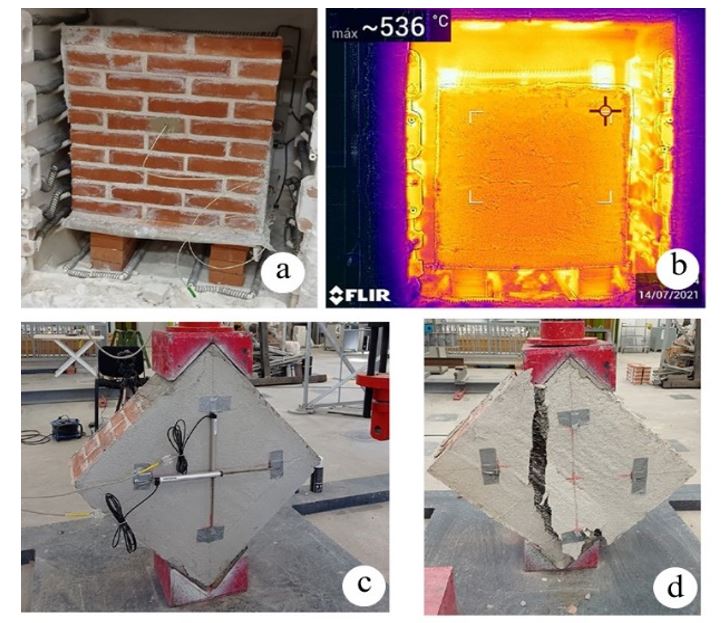Video Article Open Access
High Temperatures on Masonry Walls Retrofitted with Textile Reinforced Mortars: Effectiveness of the Reinforcement
Salvador Ivorra*, Benjamin Torres, Luis Estevan, Francisco Javier Baeza, Borja Varona
Civil Engineering Department, Universidad de Alicante, San Vicente del Raspeig (Alicante) 03690, Spain
Vid. Proc. Adv. Mater., Volume 3, Article ID 2203259 (2022)
DOI: 10.5185/vpoam.2022.03259
Publication Date (Web): 20 Jul 2022
Copyright © IAAM
Graphical Abstract

Abstract
This work focuses on the study of the behavior of masonry structures reinforced with Textile Reinforced Mortars (TRM). Many of these constructions are part of the historical heritage and the application of the reinforcement must be compatible with the construction and its use [1]. In recent years, numerous studies have been carried out to analyze the resistant behavior of this type of structure against different types of loads, especially those of seismic origin that produce increases in the lateral forces acting on the constructions [2]. Many of these studies include the use of different types of retrofitting systems including TRM with glass, carbon or basalt fibers [3,4]. This reinforcement also makes it possible to consolidate some situations of deterioration that have occurred over the years.
This work presents the experimental study carried out at the Civil Engineering Labs at the University of Alicante to analyze the behavior of this type of reinforcement when they are previously subjected to high temperature conditions, 600 ºC, which could be caused as a result of a fire. In this work, walls subjected to diagonal compression reinforced with different composite materials (glass, basalt, carbon) with a cement base subjected to high temperatures and subsequently subjected to diagonal compression loads have been analyzed.
In general terms, the results show that TRMs with carbon fibers present a better response in these conditions, can restore the walls to their original capacity and provide additional ductility, while reinforcements with glass fibers seem to be more affected by temperature.
The results show that the structural response of these reinforced elements differs considerably depending on the type of TRM used, especially the type of fiber material used. In the work, conclusions are presented regarding the preparation of the materials for installation, especially in those situations in which fires that generate high temperatures on the reinforcement material may occur. It is observed that in these situations the effectiveness of the reinforcement could be considerably reduced if the appropriate materials are not selected.
Keywords
Masonry structures; textile reinforced mortars; high temperatures.
Acknowledgement
The authors would like to acknowledge Mapei Spain and Grupo Puma for the materials supplied in this work. This research has been funded by the Spanish Ministry of Science, Innovation and Universities, grant number RTI2018-101148-B-100.
References
- L. Sorrentino, S. Cattari, F. da Porto, G. Magenes, A. Penna, Seismic behaviour of
- ordinary masonry buildings during the 2016 central Italy earthquakes, Bull. Earthq. Eng., 2019, 17, 5583.
- L.A.S. Kouris, T.C. Triantafillou, State-of-the-art on strengthening of masonry structures with textile reinforced mortar (TRM), Constr. Build. Mater., 2018, 188, 1221.
- S. Ivorra, B. Torres, F.J. Baeza, D. Bru, In-plane shear cyclic behavior of windowed masonry walls reinforced with textile reinforced mortars, Eng. Struct. 2021, 226, 111343.
- B. Torres, S. Ivorra, F. Javier Baeza, L. Estevan, B. Varona, Textile reinforced mortars (TRM) for repairing and retrofitting masonry walls subjected to in-plane cyclic loads. An experimental approach, Eng. Struct., 2021, 231.
Biography
Salvador Ivorra is full professor in the area of Continuum Mechanics and Structure Theory at the University of Alicante's Department of Civil Engineering, is the head of the research group in structure essay, simulation and modelling (GRESMES). He holds a PhD in Industrial Engineering (Mechanical Engineering) from the Polytechnic University of Valencia. Actually, is the Vice-president for Infrastructure, Sustainability and Occupational Health at the University of Alicante.
His research activity has been focused on the dynamic behaviour of structures and structural reinforcement, and he has devoted an important part of his research to the structures belonging to the historical heritage.
As of November 2021, he has authored 81 scientific articles, 62 of them in JCR-indexed journals, more than 120 papers in congresses, and has directed 17 doctoral theses. He has participated in 29 competitive research projects, 17 as senior researcher, and in more than 200 research and technical assistance contracts with public agencies and private companies. He has been responsible for the coordination of a project financed with €2,000,000 from FEDER funds for the construction of the University of Alicante’s Civil Engineering research laboratory. He is co-inventor of two patents.
Video Proceedings of Advanced Materials

Upcoming Congress



